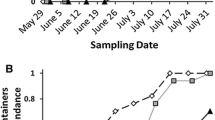Abstract
The tradeoff between colonization and competitive ability has been proposed as a mechanism for ecological succession, and this tradeoff has been demonstrated in multiple successional communities. The tradeoff between competitive ability and predation resistance is also a widely-described phenomenon; however, this tradeoff is not usually postulated as a cause of ecological succession. Early successional species that arrive before predator colonization could be either (1) less vulnerable to predation than their successors, by virtue of being poor competitors (direct competition-predation tradeoff); or (2) equally or more vulnerable to predation, because they normally colonize ahead of predators in succession and therefore are not evolutionarily adapted to avoid predators that they rarely encounter (no competition–predation tradeoff). To test these alternative hypotheses, we established water-filled containers in an oak–hickory forest. We allowed half of the containers to be naturally colonized by early-successional Culex mosquitoes, mid-successional Aedes mosquitoes, and the mosquito predator Toxorhynchites rutilus. In the other half of the containers, we prevented Aedes colonization via systematic removal of Aedes eggs, but allowed Culex and T. rutilus to colonize. The numbers of mature Culex larvae and pupae, and later the total number of Culex, were significantly greater in containers where Aedes had been removed, which suggests that Culex are competitively suppressed by Aedes. Toxorhynchites rutilus abundance and colonization rate were unaffected by the removal of Aedes, and densities of both Culex and Aedes decreased significantly with T. rutilus abundance in both treatments. In-laboratory bioassays showed that Culex were significantly more vulnerable to predation by T. rutilus than were Aedes. These data are consistent with the hypothesis that Culex and Aedes demonstrate a direct colonization–competition tradeoff, and are inconsistent with the hypothesis of a direct competition–predation tradeoff.





Similar content being viewed by others
References
Alto BW, Kesavaraju B, Juliano SA, Lounibos LP (2009) Stage-dependent predation on competitors: consequences for the outcome of a mosquito invasion. J Anim Ecol 78:928–936
Amalraj DD, Das PK (1996) Frequency-dependent prey selection by larvae of Toxorhynchites splendens (Diptera: Culicidae). Bull Entomol Res 86:633–639
Angelon KA, Petranka JW (2002) Chemicals of predatory mosquitofish (Gambusia affinis) influence selection of oviposition site by Culex mosquitoes. J Chem Ecol 28:797–806
Bates M (1949) The natural history of mosquitoes. The MacMillan Company, New York
Bentley MD, Day JF (1989) Chemical ecology and behavioral aspects of mosquito oviposition. Annu Rev Entomol 34:401–421
Bergelson JM (1985) A mechanistic interpretation of prey selection by Anax junius larvae (Odonata: Aeschnidae). Ecology 66:1699–1705
Blaustein L, Kiflawi M, Eitam A, Mangel M, Cohen J (2004) Oviposition habitat selection in response to risk of predation in temporary pools: mode of detection and consistency across experimental venue. Oecologia 138:300–305
Bradshaw WE, Holzapfel CM (1983) Predator-mediated, non-equilibrium coexistence of tree-hole mosquitoes in southeastern North America. Oecologia 57:239–256
Bradshaw WE, Holzapfel CM (1988) Drought and the organization of tree-hole mosquito communities. Oecologia 74:507–514
Cadotte MC, Mai DV, Jantz S, Collins MD, Keele M, Drake JA (2006) On testing the competition-colonization trade-off in a multispecies assemblage. Am Nat 168:704–709
Carrieri M, Bacchi M, Bellini R, Maini S (2003) On the competition occurring between Aedes albopictus and Culex pipiens (Diptera: Culicidae) in Italy. Environ Entomol 32:1313–1321
Chase JM, Leibold MA (2003) Ecological niches: linking classical and contemporary approaches, 1st edn. University of Chicago Press, Chicago
Connell JH, Slayter RO (1977) Mechanisms of succession in natural communities and their role in community stability and organization. Am Nat 111:1119–1144
Costanzo KS, Mormann K, Juliano SA (2005a) Asymmetrical competition and patterns of abundance of Aedes albopictus and Culex pipiens (Diptera: Culicidae). J Med Entomol 42:559–570
Costanzo KS, Kesavaraju B, Juliano SA (2005b) Condition-specific competition in container mosquitoes: the role of non-competing life-history stages. Ecology 86:3289–3295
Dodge HR (1964) Larval chaetotaxy and notes on the biology of Toxorhynchites rutilus septentrionalis. Ann Entomol Soc Am 57:46–53
Elliot JM (2004) Prey switching in four species of carnivorous stoneflies. Freshw Biol 49:709–720
Farajollahi A, Kesavaraju B, Nelder MP, Crans SC, Gaugler R (2009) An unusual larval collection and survival of Orthopodomyia signifera in the presence of the predator Toxorhynchites rutilus septentrionalis. J Am Mosq Control Assoc 25:370–373
Gleeson SK, Tilman D (1994) Plant allocation, growth rate, and successional status. Funct Ecol 8:543–550
Godoy O, Valladares F, Castro-Diez P (2011) Multispecies comparison reveals that invasive and native plants differ in their traits but not in their plasticity. Funct Ecol 25:1248–1259
Griswold MW, Lounibos LP (2006) Predator identity and additive effects in a treehole community. Ecology 87:987–995
Higgs P, Fox BJ (1993) Interspecific competition: a mechanism for rodent succession after fire heathland. Aust J Ecol 18:193–201
Jones CJ, Schreiber ET (1994a) Color and height affects oviposition site preferences of in wet Toxorhynchites splendens and Toxorhynchites rutilus rutilus (Diptera: Culicidae) in the laboratory. Environ Entomol 23:130–135
Jones CJ, Schreiber ET (1994b) The carnivores, Toxorhynchites. Wing Beats 5:4
Juliano SA (2007) Population dynamics. J Am Mosq Control Assoc 23(2 Suppl):265–275
Juliano SA (2009) Species interactions among larval mosquitoes: Context dependence across habitat gradients. Annu Rev Entomol 54:37–56
Kennedy PG, Higgins LM, Rogers RH, Weber MG (2011) Colonization-competition tradeoffs as a mechanism driving successional dynamics in ectomycorrhizal fungal communities. PLoS ONE 6:1–10
Kesavaraju B, Damal K, Juliano SA (2008) Do natural container habitats impede invader dominance? Predator-mediated coexistence of invasive and native container-dwelling mosquitoes. Oecologia 155:631–639
Leibold MA (1996) A graphical model of keystone predators in food webs: trophic regulation of abundance, incidence, and diversity patterns in communities. Am Nat 147:784–812
Linley JR (1995) Behavior on approach to surface prey by larvae of Toxorhynchites amboinensis and T. brevipalpis (Diptera: Culicidae). J Med Entomol 32:53–65
Linley JR, Darling K (1993) Search behavior associated with egg cannibalism in Toxorhynchites amboinensis and Toxorhynchites rutilus rutilus (Diptera: Culicidae). J Med Entomol 30:561–570
McCook LJ (1994) Understanding ecological community succession—casual-models and theories, a review. Vegetatio 110:115–147
Menge BA (1976) Organization of the New England rocky intertidal community: role of predation, competition, and environmental heterogeneity. Ecol Monogr 46:355–393
Murrell EG, Juliano SA (2012) Competitive abilities in experimental microcosms are accurately predicted by a demographic index for R*. PLoS ONE 7(9):e43458. doi:10.1371/journal.pone.0043458
Pinder JE III (1975) Effects of species removal on an old-field plant community. Ecology 56:747–751
Reiskind MH, Wilson ML (2004) Culex restuans (Diptera: Culicidae) oviposition behavior determined by larval habitat quality and quantity in southeastern Michigan. J Med Entomol 41:179–186
Rey JR, Nishimura N, Wagner B, Braks MAH, O’Connell SM (2006) Habitat segregation of mosquito arbovirus vectors in south Florida. J Med Entomol 43:1134–1141
Rueda LM, Patel KJ, Axtell RC, Stinner RE (1990) Temperature-dependent development and survival rates of Culex quinquefasciatus and Aedes aegypti (Diptera: Culicidae). J Med Entomol 25:892–898
SAS Institute (1990) SAS/Stat User’s Guide. Version 6, 4th edn. SAS Institute, Cary, NC
Tilman D (1994) Competition and biodiversity in spatially structured habitats. Ecology 75:2–16
Tirok K, Gaedke U (2010) Internally driven alternation of functional traits in a multispecies predator-prey system. Ecology 91:1748–1762
Van Dam AR, Walton WE (2008) The effects of predatory fish exudates on the ovipositional behavior of three mosquito species: Culex quinquefaciatus, Aedes aegypti and Culex tarsalis. Med Vet Entomol 22:399–404
Viola DV, Mordecai EA, Jaramillo AG, Sistla SA, Albertson LK, Gosnell JS, Carinale BJ, Levine JM (2010) Competition-defense tradeoffs and the maintenance of plant diversity. Proc Natl Acad Sci USA 107:17217–17222
Wellborn GA, Skelly DK, Werner EE (1996) Mechanisms creating community structure across a freshwater habitat gradient. Annu Rev Ecol Syst 27:337–363
Wissinger SA, Whiteman HH, Sparks GB, Rouse GL, Brown WS (1999) Foraging trade-offs along a predator-permanence gradient in subalpine wetlands. Ecology 80:2102–2116
Yee DA (2008) Tires as habitats for mosquitoes: a review of studies within the eastern United States. J Med Entomol 45:581–593
Yee DA, Kneitel JM, Juliano SA (2010) Environmental correlates of abundances of mosquito species and stages in discarded vehicle tires. J Med Entomol 47:53–62
Acknowledgments
We would like to thank J.A. Breaux, J.M. Chase, T.L. Dickson, D. Kovcic, C.R. Stephens, and C.S. Tillman for their assistance in the field, J.M. Chase and the Tyson Research Center staff for the use of their research facilities, N. Vick for her assistance in the laboratory, A.R. Ives for his assistance with statistics, and R.C. Anderson, V.A. Borowicz, T.E. Miller, W.L. Perry, J. Shurin, and three anonymous reviewers for their comments on the manuscript. This research was funded by the Beta Lambda chapter of Phi Sigma Society, and by NIAID grant R15 AI075306-01.
Author information
Authors and Affiliations
Corresponding author
Additional information
Communicated by Jonathan Shurin.
Electronic supplementary material
Below is the link to the electronic supplementary material.
Rights and permissions
About this article
Cite this article
Murrell, E.G., Juliano, S.A. Predation resistance does not trade off with competitive ability in early-colonizing mosquitoes. Oecologia 173, 1033–1042 (2013). https://doi.org/10.1007/s00442-013-2674-z
Received:
Accepted:
Published:
Issue Date:
DOI: https://doi.org/10.1007/s00442-013-2674-z




